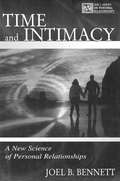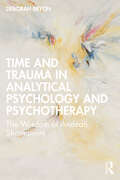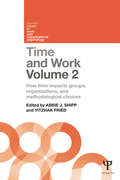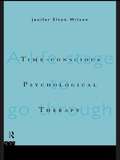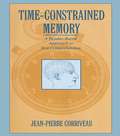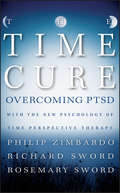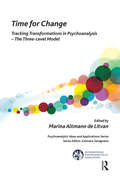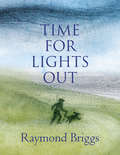- Table View
- List View
Time and Intimacy: A New Science of Personal Relationships (LEA's Series on Personal Relationships)
by Joel B. BennettThere is a mysterious connection between our experiences of intimacy--of love, the longing to feel connected, and sexual embrace--and the human sense of time--eternity, impermanence, and rhythm. In this critical analysis of the time-intimacy equation, Bennett shows how the scientific study of personal relationships can address this mystery. As a study of transpersonal science, this book points to the possible evolution of intimacy and of our consciousness of time, and how the two evolutionary paths weave together. Dr. Bennett draws from a wide array of resources to advance and marry two compelling themes: first, the social and clinical science of personal relationships should integrate the spiritual or transpersonal dimension of intimacy, and second, science can contribute to lay understandings by describing the richly temporal aspects of relationships. In blending popular literature, transpersonal psychology, and scientific research and theory, this work also attempts to address the lack of dialogue between academics who study personal intimacy and those writers in the popular press who give advice and guidelines for building intimacy. Time and Intimacy is written for a broad audience, intended for those with a general interest in relationships, as well as for students, counselors, and psychologists. It can be used as a text in courses on personal relationships, as well as to supplement courses in humanistic psychology, transpersonal psychology, interpersonal communication, relationships, marital and family counseling, human relations, and related areas. Because it advances an interdisciplinary understanding of personal relationships, this book is certain to challenge prevailing views about the meaning of intimacy in both the academic and popular literatures.
Time and Intimacy: A New Science of Personal Relationships (LEA's Series on Personal Relationships)
by Joel B. BennettThere is a mysterious connection between our experiences of intimacy--of love, the longing to feel connected, and sexual embrace--and the human sense of time--eternity, impermanence, and rhythm. In this critical analysis of the time-intimacy equation, Bennett shows how the scientific study of personal relationships can address this mystery. As a study of transpersonal science, this book points to the possible evolution of intimacy and of our consciousness of time, and how the two evolutionary paths weave together. Dr. Bennett draws from a wide array of resources to advance and marry two compelling themes: first, the social and clinical science of personal relationships should integrate the spiritual or transpersonal dimension of intimacy, and second, science can contribute to lay understandings by describing the richly temporal aspects of relationships. In blending popular literature, transpersonal psychology, and scientific research and theory, this work also attempts to address the lack of dialogue between academics who study personal intimacy and those writers in the popular press who give advice and guidelines for building intimacy. Time and Intimacy is written for a broad audience, intended for those with a general interest in relationships, as well as for students, counselors, and psychologists. It can be used as a text in courses on personal relationships, as well as to supplement courses in humanistic psychology, transpersonal psychology, interpersonal communication, relationships, marital and family counseling, human relations, and related areas. Because it advances an interdisciplinary understanding of personal relationships, this book is certain to challenge prevailing views about the meaning of intimacy in both the academic and popular literatures.
Time and Memory
by Rosine Jozef PerelbergThe concern with time permeates Freud's work, from Studies on Hysteria to Analysis Terminable and Interminable, which point out to a network of concepts that indicate Freud's complex theories on temporality. Indeed no other psychoanalytic thinker has put forward such revolutionary vision on the dimensions of time in human existence. This volume brings together some of the most important papers written on the topic by members of the British Psychoanalytical Society. In the richness of the detailed clinical discussions the ways in which patients deal with time and memory are viewed as crucial indications about their internal world and ways of relating to their objects. Disorientation regarding time tends to reflect levels of disruption to internal object relationships, inability to mourn or to experience guilt. Examples from literature and history are considered in order to examine the power of the repetition compulsion - Nachtreglichkeit - as well as how the impossibility of bearing the mental pain can lead to the creation of a timeless world.
Time and Memory (Psychoanalytic Ideas Ser.)
by Paul Williams Rosine Jozef Perelberg Inge WiseThe concern with time permeates Freud's work, from Studies on Hysteria to Analysis Terminable and Interminable, which point out to a network of concepts that indicate Freud's complex theories on temporality. Indeed no other psychoanalytic thinker has put forward such revolutionary vision on the dimensions of time in human existence. This volume brings together some of the most important papers written on the topic by members of the British Psychoanalytical Society. In the richness of the detailed clinical discussions the ways in which patients deal with time and memory are viewed as crucial indications about their internal world and ways of relating to their objects. Disorientation regarding time tends to reflect levels of disruption to internal object relationships, inability to mourn or to experience guilt. Examples from literature and history are considered in order to examine the power of the repetition compulsion - Nachtreglichkeit - as well as how the impossibility of bearing the mental pain can lead to the creation of a timeless world.
Time and the Psyche: Jungian Perspectives
by Angeliki YiassemidesIn Time and the Psyche, a diverse selection of contributors explores the multi-layered aspects of time through the lens of analytical psychology. The book aims to bridge the gap between theory and practice, emphasising time's fundamental role in the workings and expressions of the psyche, and additionally exploring cultural and clinical dimensions. The contributors deal with temporality in our inner world and its manifestations as expressed by products of our psyche, covering topics including disturbances of temporality within the psychoanalytic session, the acausal connecting principle of synchronicity, time as expressed in film, objects, literature, and culture, and temporality as understood in various types of dreams and imaginary practices. The book also explores the time-bound world, time versus timelessness, the realm of the eternal, human versus cosmic time, Chronos versus Kairos and other temporality-related dimensions and their relationship to our psyche and our experience in the world. With contributors from backgrounds in clinical work, the arts, literature, and philosophy, this collection is unique in its scope. Time and the Psyche is a thought-provoking reading for academics and students of Jungian and post-Jungian studies, analytical psychologists and Jungian analysts in practice and in training.
Time and the Psyche: Jungian Perspectives
by Angeliki YiassemidesIn Time and the Psyche, a diverse selection of contributors explores the multi-layered aspects of time through the lens of analytical psychology. The book aims to bridge the gap between theory and practice, emphasising time's fundamental role in the workings and expressions of the psyche, and additionally exploring cultural and clinical dimensions. The contributors deal with temporality in our inner world and its manifestations as expressed by products of our psyche, covering topics including disturbances of temporality within the psychoanalytic session, the acausal connecting principle of synchronicity, time as expressed in film, objects, literature, and culture, and temporality as understood in various types of dreams and imaginary practices. The book also explores the time-bound world, time versus timelessness, the realm of the eternal, human versus cosmic time, Chronos versus Kairos and other temporality-related dimensions and their relationship to our psyche and our experience in the world. With contributors from backgrounds in clinical work, the arts, literature, and philosophy, this collection is unique in its scope. Time and the Psyche is a thought-provoking reading for academics and students of Jungian and post-Jungian studies, analytical psychologists and Jungian analysts in practice and in training.
Time and Timelessness: Temporality in the theory of Carl Jung (Research in Analytical Psychology and Jungian Studies)
by Angeliki YiassemidesTime and Timelessness examines the development of Jung's understanding of time throughout his opus, and the ways in which this concept has affected key elements of his work. In this book Yiassemides suggests that temporality plays an important role in many of Jung's central ideas, and is closely interlinked with his overall approach to the psyche and the cosmos at large. Jung proposed a profound truth: that time is relative at large. To appreciate the whole of our experience we must reach beyond causality and temporal linearity, to develop an approach that allows for multidimensional and synchronistic experiences. Jung’s understanding surpassed Freud's dichotomous approach which restricted timelessness to the unconscious; his time theory allows us to reach beyond the everyday time-bound world into a greater realm, rich with meaning and connection. Included in the book: -Jung’s time theory -the death of time -time and spatial metaphors -the role of time in precognition, telepathy and synchronicity -Unus mundus and time -a comparison of Freud’s and Jung’s time theories: temporal directionality, dimensionality, and the role of timelessness. This book is the first to explore time and timelessness in a systematic manner from a Jungian perspective, and the first to investigate how the concept of time affected the overall development of Jung's theory. It will be key reading for psychoanalytic scholars and clinicians, as well as those working in the field of phenomenological philosophy.
Time and Timelessness: Temporality in the theory of Carl Jung (Research in Analytical Psychology and Jungian Studies)
by Angeliki YiassemidesTime and Timelessness examines the development of Jung's understanding of time throughout his opus, and the ways in which this concept has affected key elements of his work. In this book Yiassemides suggests that temporality plays an important role in many of Jung's central ideas, and is closely interlinked with his overall approach to the psyche and the cosmos at large. Jung proposed a profound truth: that time is relative at large. To appreciate the whole of our experience we must reach beyond causality and temporal linearity, to develop an approach that allows for multidimensional and synchronistic experiences. Jung’s understanding surpassed Freud's dichotomous approach which restricted timelessness to the unconscious; his time theory allows us to reach beyond the everyday time-bound world into a greater realm, rich with meaning and connection. Included in the book: -Jung’s time theory -the death of time -time and spatial metaphors -the role of time in precognition, telepathy and synchronicity -Unus mundus and time -a comparison of Freud’s and Jung’s time theories: temporal directionality, dimensionality, and the role of timelessness. This book is the first to explore time and timelessness in a systematic manner from a Jungian perspective, and the first to investigate how the concept of time affected the overall development of Jung's theory. It will be key reading for psychoanalytic scholars and clinicians, as well as those working in the field of phenomenological philosophy.
Time and Trauma in Analytical Psychology and Psychotherapy: The Wisdom of Andean Shamanism
by Deborah BryonThis book explores the experience of time in psychoanalysis and Andean shamanism. It plots ways to work through unresolved trauma by expanding how we conceptualize both implicit and nonverbal atemporal experience, drawing from the rituals, narratives, and medicine of Andean shamans and quantum theory.Shifting between subjective states in time is fundamental in trauma work and psychoanalysis. Integrating traumatic experiences that have become split off and held in “timeless” unconscious states of implicit memory is an essential aspect of psychic healing. Becoming familiar with the Andean shamans’ understanding of atemporal experience, as well as learning about their ways of “grounding” the experience consciously, can offer a route through which psychoanalysis and therapy may deepen the therapeutic process and open new states of consciousness. Theories developed in quantum physics are included to parallel the shamans’ experience and for describing the analytic process.Written by a noted expert in this field, this insightful volume will interest trainee and practitioner analytical psychologists, as well as any professional interested in the resolution of trauma within a psychotherapeutic setting.
Time and Trauma in Analytical Psychology and Psychotherapy: The Wisdom of Andean Shamanism
by Deborah BryonThis book explores the experience of time in psychoanalysis and Andean shamanism. It plots ways to work through unresolved trauma by expanding how we conceptualize both implicit and nonverbal atemporal experience, drawing from the rituals, narratives, and medicine of Andean shamans and quantum theory.Shifting between subjective states in time is fundamental in trauma work and psychoanalysis. Integrating traumatic experiences that have become split off and held in “timeless” unconscious states of implicit memory is an essential aspect of psychic healing. Becoming familiar with the Andean shamans’ understanding of atemporal experience, as well as learning about their ways of “grounding” the experience consciously, can offer a route through which psychoanalysis and therapy may deepen the therapeutic process and open new states of consciousness. Theories developed in quantum physics are included to parallel the shamans’ experience and for describing the analytic process.Written by a noted expert in this field, this insightful volume will interest trainee and practitioner analytical psychologists, as well as any professional interested in the resolution of trauma within a psychotherapeutic setting.
Time and Work, Volume 1: How time impacts individuals
by Abbie J. Shipp Yitzhak FriedThe concept of time is a crucial filter through which we understand any events or phenomena; nothing exists outside of time. It conditions not only the question of ‘when’, but also influences the ‘what, how and why’ of our ideas about management. And yet management scholars have rarely considered this ‘temporal lens’ in understanding how time affects employees at work, or the organizations for which they work. This 2-volume set provides a fresh, temporal perspective on some of the most important and thriving areas in management research today. Volume 1 considers how time impacts the individual, and includes chapters on identity, emotion, motivation, stress and creativity. Volume 2 considers time in context with the organization, exploring a temporal understanding of leadership, HRM, entrepreneurship, teams and cross-cultural issues. There is an overall concern with the practical implications of understanding individuals and organizations within the most relevant timeframes, while the two volumes provide an actionable research agenda for the future. This is a highly significant contribution to management theory and research, and will be important reading for all students and researchers of Organizational Behavior, Organizational Psychology, Occupational Psychology, Business and Management and HRM.
Time and Work, Volume 1: How time impacts individuals
by Abbie J. Shipp Yitzhak FriedThe concept of time is a crucial filter through which we understand any events or phenomena; nothing exists outside of time. It conditions not only the question of ‘when’, but also influences the ‘what, how and why’ of our ideas about management. And yet management scholars have rarely considered this ‘temporal lens’ in understanding how time affects employees at work, or the organizations for which they work. This 2-volume set provides a fresh, temporal perspective on some of the most important and thriving areas in management research today. Volume 1 considers how time impacts the individual, and includes chapters on identity, emotion, motivation, stress and creativity. Volume 2 considers time in context with the organization, exploring a temporal understanding of leadership, HRM, entrepreneurship, teams and cross-cultural issues. There is an overall concern with the practical implications of understanding individuals and organizations within the most relevant timeframes, while the two volumes provide an actionable research agenda for the future. This is a highly significant contribution to management theory and research, and will be important reading for all students and researchers of Organizational Behavior, Organizational Psychology, Occupational Psychology, Business and Management and HRM.
Time and Work, Volume 2: How time impacts groups, organizations and methodological choices
by Abbie J. Shipp Yitzhak FriedThe concept of time is a crucial filter through which we understand any events or phenomena; nothing exists outside of time. It conditions not only the question of ‘when’, but also influences the ‘what, how and why’of our ideas about management. And yet management scholars have rarely considered this ‘temporal lens’ in understanding how time affects employees at work, or the organizations for which they work. This 2-volume set provides a fresh, temporal perspective on some of the most important and thriving areas in management research today. Volume 1 considers how time impacts the individual, and includes chapters on identity, emotion, motivation, stress and creativity. Volume 2 considers time in context with the organization, exploring a temporal understanding of leadership, HRM, entrepreneurship, teams and cross-cultural issues. There is an overall concern with the practical implications of understanding individuals and organizations within the most relevant timeframes, while the two volumes provide an actionable research agenda for the future. This is a highly significant contribution to management theory and research, and will be important reading for all students and researchers of Organizational Behavior, Organizational Psychology, Occupational Psychology, Business and Management and HRM.
Time and Work, Volume 2: How time impacts groups, organizations and methodological choices
by Abbie J. Shipp Yitzhak FriedThe concept of time is a crucial filter through which we understand any events or phenomena; nothing exists outside of time. It conditions not only the question of ‘when’, but also influences the ‘what, how and why’of our ideas about management. And yet management scholars have rarely considered this ‘temporal lens’ in understanding how time affects employees at work, or the organizations for which they work. This 2-volume set provides a fresh, temporal perspective on some of the most important and thriving areas in management research today. Volume 1 considers how time impacts the individual, and includes chapters on identity, emotion, motivation, stress and creativity. Volume 2 considers time in context with the organization, exploring a temporal understanding of leadership, HRM, entrepreneurship, teams and cross-cultural issues. There is an overall concern with the practical implications of understanding individuals and organizations within the most relevant timeframes, while the two volumes provide an actionable research agenda for the future. This is a highly significant contribution to management theory and research, and will be important reading for all students and researchers of Organizational Behavior, Organizational Psychology, Occupational Psychology, Business and Management and HRM.
Time-conscious Psychological Therapy
by Jenifer Elton WilsonCounselors and psychotherapists are divided about the morality and efficacy of short-term psychotherapy and counseling. The model of therapy described Time-Conscious Psychological Therapy is based on flexible adjustment to the life pattern of the individual client's development, showing how a carefully structured, stage-based series of therapeutic relationships can be rewarding for both client and therapist. Illustrated throughout by case examples, this is a book for practitioners of all psychological therapies who are looking for a rigorous but flexible approach to empowering their clients.
Time-conscious Psychological Therapy
by Jenifer Elton WilsonCounselors and psychotherapists are divided about the morality and efficacy of short-term psychotherapy and counseling. The model of therapy described Time-Conscious Psychological Therapy is based on flexible adjustment to the life pattern of the individual client's development, showing how a carefully structured, stage-based series of therapeutic relationships can be rewarding for both client and therapist. Illustrated throughout by case examples, this is a book for practitioners of all psychological therapies who are looking for a rigorous but flexible approach to empowering their clients.
Time-conscious Psychological Therapy: A Life Stage to Go Through
by Jenifer Elton WilsonCounselors and psychotherapists are divided about the morality and efficacy of short-term psychotherapy and counseling. The model of therapy described Time-Conscious Psychological Therapy is based on flexible adjustment to the life pattern of the individual client's development, showing how a carefully structured, stage-based series of therapeutic relationships can be rewarding for both client and therapist. Illustrated throughout by case examples, this is a book for practitioners of all psychological therapies who are looking for a rigorous but flexible approach to empowering their clients.
Time-conscious Psychological Therapy: A Life Stage to Go Through (PDF)
by Jenifer Elton WilsonCounselors and psychotherapists are divided about the morality and efficacy of short-term psychotherapy and counseling. The model of therapy described Time-Conscious Psychological Therapy is based on flexible adjustment to the life pattern of the individual client's development, showing how a carefully structured, stage-based series of therapeutic relationships can be rewarding for both client and therapist. Illustrated throughout by case examples, this is a book for practitioners of all psychological therapies who are looking for a rigorous but flexible approach to empowering their clients.
Time-constrained Memory: A Reader-based Approach To Text Comprehension
by Jean-Pierre CorriveauThis book tries to answer the question posed by Minsky at the beginning of The Society of Mind: "to explain the mind, we have to show how minds are built from mindless stuff, from parts that are much smaller and simpler than anything we'd considered smart." The author believes that cognition should not be rooted in innate rules and primitives, but rather grounded in human memory. More specifically, he suggests viewing linguistic comprehension as a time-constrained process -- a race for building an interpretation in short term memory. After reviewing existing psychological and computational approaches to text understanding and concluding that they generally rely on self-validating primitives, the author abandons this objectivist and normative approach to meaning and develops a set of requirements for a grounded cognitive architecture. He then goes on to explain how this architecture must avoid all epistemological commitments, be tractable both with respect to space and time, and, most importantly, account for the diachronic and non-deterministic nature of comprehension. In other words, a text may or may not lead to an interpretation for a specific reader, and may be associated with several interpretations over time by one reader. Throughout the remainder of the book, the author demonstrates that rules for all major facets of comprehension -- syntax, reference resolution, quantification, lexical and structural disambiguation, inference and subject matter -- can be expressed in terms of the simple mechanistic computing elements of a massively parallel network modeling memory. These elements, called knowledge units, work in a limited amount of time and have the ability not only to recognize but also to build the structures that make up an interpretation. Designed as a main text for graduate courses, this volume is essential to the fields of cognitive science, artificial intelligence, memory modeling, text understanding, computational linguistics and natural language understanding. Other areas of application are schema-matching, hermeneutics, local connectionism, and text linguistics. With its extensive bibliography, the book is also valuable as supplemental reading for introductory undergraduate courses in cognitive science and computational linguistics.
Time-constrained Memory: A Reader-based Approach To Text Comprehension
by Jean-Pierre CorriveauThis book tries to answer the question posed by Minsky at the beginning of The Society of Mind: "to explain the mind, we have to show how minds are built from mindless stuff, from parts that are much smaller and simpler than anything we'd considered smart." The author believes that cognition should not be rooted in innate rules and primitives, but rather grounded in human memory. More specifically, he suggests viewing linguistic comprehension as a time-constrained process -- a race for building an interpretation in short term memory. After reviewing existing psychological and computational approaches to text understanding and concluding that they generally rely on self-validating primitives, the author abandons this objectivist and normative approach to meaning and develops a set of requirements for a grounded cognitive architecture. He then goes on to explain how this architecture must avoid all epistemological commitments, be tractable both with respect to space and time, and, most importantly, account for the diachronic and non-deterministic nature of comprehension. In other words, a text may or may not lead to an interpretation for a specific reader, and may be associated with several interpretations over time by one reader. Throughout the remainder of the book, the author demonstrates that rules for all major facets of comprehension -- syntax, reference resolution, quantification, lexical and structural disambiguation, inference and subject matter -- can be expressed in terms of the simple mechanistic computing elements of a massively parallel network modeling memory. These elements, called knowledge units, work in a limited amount of time and have the ability not only to recognize but also to build the structures that make up an interpretation. Designed as a main text for graduate courses, this volume is essential to the fields of cognitive science, artificial intelligence, memory modeling, text understanding, computational linguistics and natural language understanding. Other areas of application are schema-matching, hermeneutics, local connectionism, and text linguistics. With its extensive bibliography, the book is also valuable as supplemental reading for introductory undergraduate courses in cognitive science and computational linguistics.
The Time Cure: Overcoming PTSD with the New Psychology of Time Perspective Therapy
by Philip Zimbardo Richard Sword Rosemary SwordIn his landmark book, The Time Paradox, internationally known psychologist Philip Zimbardo showed that we can transform the way we think about our past, present, and future to attain greater success in work and in life. Now, in The Time Cure, Zimbardo has teamed with clinicians Richard and Rosemary Sword to reveal a groundbreaking approach that helps those living with post-traumatic stress disorder (PTSD) to shift their time perspectives and move beyond the traumatic past toward a more positive future. Time Perspective Therapy switches the focus from past to present, from negative to positive, clearing the pathway for the best yet to come: the future. It helps PTSD sufferers pull their feet out of the quicksand of past traumas and step firmly on the solid ground of the present, allowing them to take a step forward into a brighter future. Rather than viewing PTSD as a mental illness the authors see it as a mental injury—a normal reaction to traumatic events—and offer those suffering from PTSD the healing balm of hope. The Time Cure lays out the step-by-step process of Time Perspective Therapy, which has proven effective for a wide range of individuals, from veterans to survivors of abuse, accidents, assault, and neglect. Rooted in psychological research, the book also includes a wealth of vivid and inspiring stories from real-life PTSD sufferers—effective for individuals seeking self-help, their loved ones, therapists and counselors, or anyone who wants to move forward to a brighter future.
The Time Cure: Overcoming PTSD with the New Psychology of Time Perspective Therapy
by Philip Zimbardo Richard Sword Rosemary SwordIn his landmark book, The Time Paradox, internationally known psychologist Philip Zimbardo showed that we can transform the way we think about our past, present, and future to attain greater success in work and in life. Now, in The Time Cure, Zimbardo has teamed with clinicians Richard and Rosemary Sword to reveal a groundbreaking approach that helps those living with post-traumatic stress disorder (PTSD) to shift their time perspectives and move beyond the traumatic past toward a more positive future. Time Perspective Therapy switches the focus from past to present, from negative to positive, clearing the pathway for the best yet to come: the future. It helps PTSD sufferers pull their feet out of the quicksand of past traumas and step firmly on the solid ground of the present, allowing them to take a step forward into a brighter future. Rather than viewing PTSD as a mental illness the authors see it as a mental injury—a normal reaction to traumatic events—and offer those suffering from PTSD the healing balm of hope. The Time Cure lays out the step-by-step process of Time Perspective Therapy, which has proven effective for a wide range of individuals, from veterans to survivors of abuse, accidents, assault, and neglect. Rooted in psychological research, the book also includes a wealth of vivid and inspiring stories from real-life PTSD sufferers—effective for individuals seeking self-help, their loved ones, therapists and counselors, or anyone who wants to move forward to a brighter future.
Time for Change: Tracking Transformations in Psychoanalysis - The Three-Level Model (The International Psychoanalytical Association Psychoanalytic Ideas and Applications Series)
by Marina Altmann de LitvanThis book presents a research work on transformations in psychoanalysis and clinical observation of changes in psychoanalysis. It compares, based on the "three-level model", the different points of view of psychoanalysts from all over the world and from different psychoanalytical cultures.
Time for Change: Tracking Transformations in Psychoanalysis - The Three-Level Model (The International Psychoanalytical Association Psychoanalytic Ideas and Applications Series)
by Marina Altmann de LitvanThis book presents a research work on transformations in psychoanalysis and clinical observation of changes in psychoanalysis. It compares, based on the "three-level model", the different points of view of psychoanalysts from all over the world and from different psychoanalytical cultures.
Time For Lights Out
by Raymond BriggsIn his customary pose as the grumpiest of grumpy old men, Raymond Briggs contemplates old age and death… and doesn’t like them much. Illustrated with Briggs’s inimitable pencil drawings, Time for Lights Out is a collection of short pieces, some funny, some melancholy, some remembering his wife who died young, others about the joy of grandchildren, of walking the dog… He looks back at his schooldays and his time as an evacuee during the war, and remembers his parents and the house in which he grew up. But most, like this one, are about his home in Sussex:Looking round this house,What will they say, The future ghosts?There must have been Some barmy old bloke here,Long-haired, artsy-fartsy type, Did pictures for kiddy books Or some such tripe.You should have seen the stuff He stuck up in that attic!Snowman this and snowman that,Tons and tons of tat.
